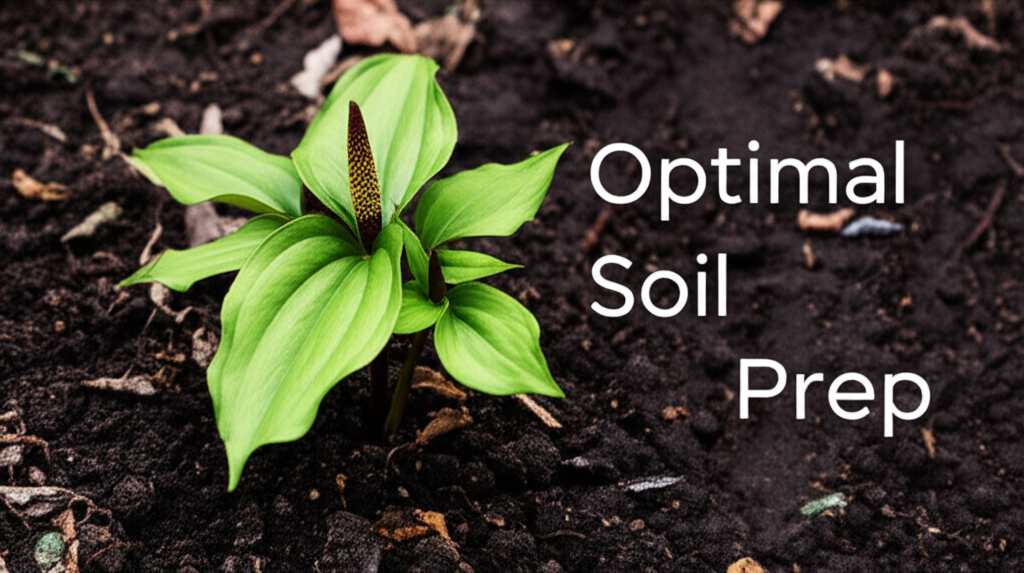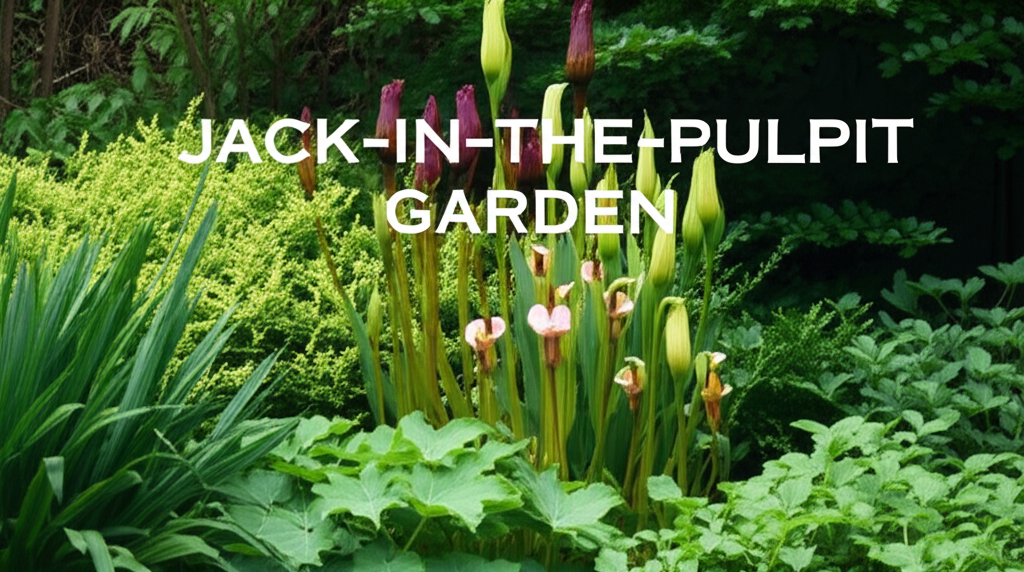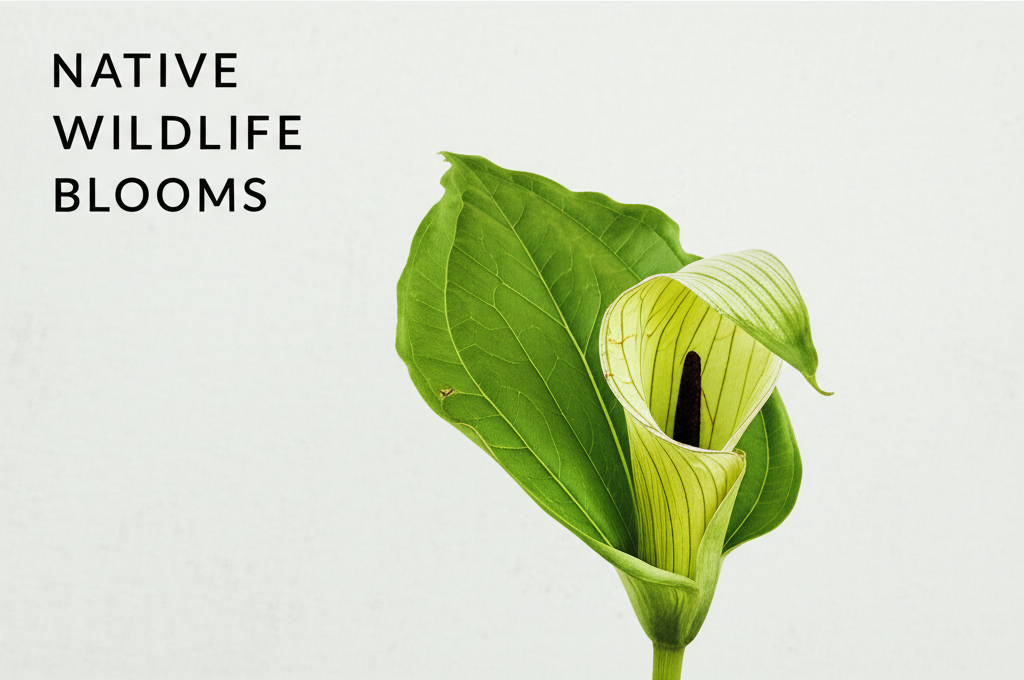Unveiling the Mysteries of Jack-in-the-Pulpit Soil Needs
The Jack-in-the-Pulpit (Arisaema triphyllum) is a captivating woodland native, renowned for its unique spathe and spadix, often resembling a preacher in its pulpit. Beyond its botanical intrigue, this plant possesses a fascinating life cycle and specific environmental requirements for optimal growth. One of the most crucial aspects of successfully cultivating this woodland jewel lies in understanding and meticulously preparing its soil. Getting the soil right is not merely a suggestion; it’s a foundational element that dictates the plant’s vigor, bloom potential, and overall resilience. This comprehensive guide will delve deep into the nuances of soil preparation for Jack-in-the-Pulpit, ensuring your plants flourish in their recreated woodland habitat.
The Natural Habitat: A Clue to Optimal Soil
To truly understand what Jack-in-the-Pulpit needs, we must first look to its native environment. These plants typically thrive in moist, shaded woodlands, often found in deciduous forests. Here, the soil is a rich tapestry woven from decomposed organic matter, leaf litter, and the remnants of fallen trees and plants. This constant cycle of decomposition creates a soil that is:
- Rich in organic matter: This provides essential nutrients and improves soil structure.
- Consistently moist: The canopy of mature trees filters sunlight and retains moisture in the soil.
- Well-draining: While moisture is key, waterlogged conditions can lead to root rot. The presence of natural debris allows for adequate drainage.
- Slightly acidic to neutral pH: The decomposition of leaves and wood often contributes to a slightly acidic environment.
Mimicking these conditions in your garden is the ultimate goal of effective soil preparation. Ignoring these natural preferences is a common pitfall for aspiring Jack-in-the-Pulpit growers.
Deconstructing the Ideal Jack-in-the-Pulpit Soil Mix

Achieving the perfect soil for your Jack-in-the-Pulpit involves a thoughtful combination of ingredients that replicate its natural woodland home. It’s a balance of moisture retention, drainage, and nutrient richness.
The Cornerstones of a Jack-in-the-Pulpit Soil Blend
A successful soil mix for Jack-in-the-Pulpit typically comprises several key components, each playing a vital role in supporting the plant’s health.
1. Organic Matter: The Lifeblood of Woodland Soils
Organic matter is paramount. It acts as a sponge, retaining moisture essential for the plant, especially during drier periods. Furthermore, as it decomposes, it releases vital nutrients that fuel growth. Excellent sources of organic matter include:
- Compost: Well-rotted compost is a gardener’s best friend. It improves soil structure, adds nutrients, and enhances water retention. Aim for compost made from a variety of materials, such as kitchen scraps, yard waste, and aged manure.
- Leaf Mold: This is decomposed leaf litter, a direct replica of the forest floor. It’s particularly valuable for its ability to retain moisture and create a friable soil structure.
- Aged Manure: Ensure any manure used is well-aged (at least six months to a year) to avoid burning the plant’s roots and to allow for the breakdown of pathogens. Cow or horse manure are good options.
- Peat Moss: While a common soil amendment, it’s important to note its environmental implications. If using peat moss, consider sustainably sourced options. It excels at retaining moisture and lowering soil pH, which can be beneficial for Jack-in-the-Pulpit.
2. Drainage Enhancers: Preventing the dreaded Root Rot
While Jack-in-the-Pulpit enjoys moist soil, it absolutely detests soggy feet. Proper drainage is critical to prevent fungal diseases and root rot, which can quickly decimate these plants. Incorporating materials that improve aeration and drainage is essential.
- Perlite: These lightweight, volcanic rock particles create air pockets in the soil, improving drainage and aeration without significantly altering the soil’s pH.
- Coarse Sand: Horticultural or builder’s sand (not play sand, which is too fine) can be added in moderation to improve drainage.
- Pine Bark Fines: Small, shredded pieces of pine bark contribute to drainage and aeration while also adding a slight acidic element that many woodland plants prefer.
3. Soil Structure Improvers: Creating the Perfect Texture
The ideal soil texture for Jack-in-the-Pulpit is loose, crumbly, and friable, allowing roots to penetrate easily and air to circulate.
- Sphagnum Peat Moss (as mentioned): Its fibrous nature helps create a light and airy soil.
- Composted Bark: Larger bark chips, composted down, can improve aeration and provide a slow release of nutrients.
Key Facts: Jack-in-the-Pulpit Soil Requirements
To summarize the essential soil characteristics, let’s look at a comparative table.
| Soil Characteristic | Optimal State | Why it Matters |
|---|---|---|
| Organic Matter Content | High | Provides nutrients, improves moisture retention, and enhances soil structure. |
| Moisture Retention | Good, but not waterlogged | Essential for consistent hydration, especially during active growth. |
| Drainage | Excellent | Prevents root rot and fungal diseases. |
| Soil Texture | Loose, crumbly, friable | Allows for easy root penetration and air circulation. |
| pH Level | Slightly acidic to neutral (5.5 – 7.0) | Mimics natural woodland conditions and supports nutrient availability. |
The Process: Preparing Your Soil for Planting
Preparing the soil is an investment in the future health and beauty of your Jack-in-the-Pulpit. Whether you are planting directly into the ground or preparing a container, the principles remain the same.
Step-by-Step Soil Preparation Guide
Follow these steps to create the perfect soil environment for your Arisaema triphyllum.
1. Site Selection and Initial Soil Assessment
- Shade is key: Choose a location that receives dappled shade or morning sun and afternoon shade. Avoid full sun, which can scorch the leaves and dry out the soil too quickly.
- Observe existing soil: Assess your current soil type. Is it heavy clay? Sandy? Does it drain well? This initial assessment will inform how much amendment is needed. Dig a small hole, fill it with water, and see how quickly it drains. If it takes more than a few hours for the water to dissipate, drainage needs improvement.
2. Amending Native Soil (In-Ground Planting)
- Loosen the soil: Dig the planting area to a depth of at least 8-12 inches, loosening the soil thoroughly.
- Incorporate amendments: For every cubic foot of native soil, mix in approximately 3-4 inches of your prepared soil blend. This typically involves a ratio of:
1 part compost
1 part leaf mold or aged manure
1 part perlite or coarse sand (adjust based on your native soil’s drainage)
Optional: A small amount of peat moss if your soil tends to be alkaline.
- Thorough mixing: Ensure all amendments are evenly distributed throughout the loosened soil. Work the mixture until it is homogenous.
3. Preparing Potting Mix (Container Planting)
For container-grown Jack-in-the-Pulpit, a custom potting mix is recommended.
- Base: Use a high-quality potting mix as your base.
- Amendments: To this base, add:
30% compost
20% leaf mold
10-20% perlite or coarse sand
A handful of shredded pine bark for added aeration and acidity.
- Mixing: Combine all ingredients thoroughly in a large bin or directly in the planting container.
4. Adjusting pH (If Necessary)
- Testing: If you suspect your soil is too alkaline or acidic, use a soil pH test kit.
- Lowering pH (making it more acidic): Incorporate elemental sulfur or sphagnum peat moss.
- Raising pH (making it more alkaline): Add ground limestone or wood ash. Make these adjustments well in advance of planting, as they take time to affect soil pH.
Pros and Cons of Different Soil Preparation Approaches
Understanding the advantages and disadvantages of various methods can help you make informed decisions.
| Method/Component | Pros | Cons |
|---|---|---|
| Amending Native Clay Soil | Improves drainage, aeration, and nutrient content. Creates a more hospitable environment for roots. | Can be labor-intensive. Requires significant amounts of organic matter and drainage enhancers. Incorrect amendment can lead to compacted soil. |
| Amending Native Sandy Soil | Increases moisture and nutrient retention. Improves soil structure. | Requires more organic matter to hold moisture effectively. Sandy soils can leach nutrients more quickly. |
| Using a Commercial Potting Mix | Convenient and formulated for container growing. Often provides good drainage and aeration. | Can be expensive. May not perfectly replicate the specific needs of Jack-in-the-Pulpit without additional amendments. Potential for over-fertilization if not careful. |
| Over-reliance on Peat Moss | Excellent for moisture retention and lowering pH. | Environmental concerns regarding harvesting. Can become hydrophobic if allowed to dry out completely, making rewetting difficult. |
| Using Perlite | Improves drainage and aeration without adding weight. Inert and doesn’t affect pH. | Can be dusty when handled. May float to the surface in containers over time. |
| Adding Aged Manure | Rich in nutrients, improves soil structure and water retention. | Must be well-aged to avoid burning roots. Source quality manure to avoid introducing weed seeds or pathogens. |
Maintaining Optimal Soil Conditions Post-Planting
Soil preparation doesn’t end once the plant is in the ground. Ongoing maintenance is crucial for sustained health.
Mulching: The Woodland Gardener’s Ally
Mulching is an essential practice for Jack-in-the-Pulpit. Apply a generous layer (2-3 inches) of organic mulch around the base of the plant, keeping it a few inches away from the stem.
- Benefits of Mulch:
Conserves soil moisture, reducing the need for frequent watering.
Suppresses weed growth, which competes for nutrients and water.
Regulates soil temperature, protecting roots from extreme heat and cold.
As it decomposes, it adds nutrients and improves soil structure, further enriching the soil.
- Ideal Mulch Materials:
Shredded hardwood bark
Composted wood chips
Leaf mold
Pine needles
Watering Wisdom: Finding the Balance
Water your Jack-in-the-Pulpit regularly, especially during its active growing season (spring and early summer). The soil should remain consistently moist but never waterlogged.
- Check soil moisture: Stick your finger about an inch into the soil. If it feels dry, it’s time to water.
- Water deeply: Encourage deep root growth by watering thoroughly rather than frequent shallow sprinklings.
- Avoid overhead watering: Water at the base of the plant to minimize the risk of fungal diseases on the foliage.
Fertilizing: Less is Often More
Jack-in-the-Pulpit is not a heavy feeder. If you have prepared your soil with ample organic matter, additional fertilization may not be necessary.
- Over-fertilization caution: Too much fertilizer can burn the roots and lead to excessive leaf growth at the expense of flower and seed production.
- When to fertilize: If your plants appear pale or are not growing vigorously, a light application of a balanced, slow-release organic fertilizer in early spring can be beneficial. Alternatively, a top-dressing of compost in spring and fall can provide all the necessary nutrients.
Common Pitfalls and How to Avoid Them
Even with the best intentions, growers can encounter issues. Understanding common mistakes will help you steer clear of them.
Soil-Related Problems and Solutions
- Waterlogged Soil: Leads to root rot. Solution: Improve drainage with amendments like perlite or coarse sand. Ensure containers have adequate drainage holes.
- Dry, Compacted Soil: Stunts growth and prevents root development. Solution: Incorporate plenty of organic matter to improve structure and moisture retention.
- Alkaline Soil: Can lead to nutrient deficiencies, particularly iron. Solution: Lower pH with peat moss or elemental sulfur.
- Lack of Organic Matter: Results in poor nutrient availability and weak growth. Solution: Consistently amend the soil with compost and leaf mold.
- Planting Too Deeply: Can cause the corm to rot. Solution: Plant the corm with the pointed end up, about 2-4 inches deep, depending on the corm size. The top of the corm should be just below the soil surface.
Conclusion: Cultivating a Woodland Wonder
The Jack-in-the-Pulpit is a rewarding plant to cultivate, offering a unique aesthetic and a fascinating glimpse into woodland ecology. By diligently preparing your soil with a focus on replicating its natural habitat – rich in organic matter, consistently moist yet well-draining, and with a slightly acidic to neutral pH – you lay the groundwork for thriving plants. Consistent mulching, mindful watering, and a conservative approach to fertilization will ensure your Jack-in-the-Pulpit flourishes year after year, bringing a touch of wild beauty to your garden. Remember, the soil is the silent partner in your horticultural success; treat it with care, and your Jack-in-the-Pulpit will undoubtedly thank you with its captivating presence.


